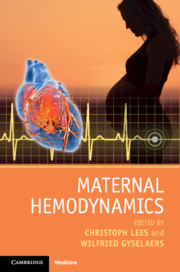Book contents
- Maternal Hemodynamics
- Maternal Hemodynamics
- Copyright page
- Contents
- Contributors
- Section 1 Physiology of Normal Pregnancy
- Chapter 1 Maternal Hemodynamics in Health and Disease: A Paradigm Shift in the Causation of Placental Syndromes
- Chapter 2 Cardiovascular and Volume Regulatory Functions in Pregnancy: An Overview
- Chapter 3 Cardiac Function
- Chapter 4 The Venous Compartment in Normal Pregnancy
- Chapter 5 The Microcirculation
- Chapter 6 Plasma Volume Changes in Pregnancy
- Section 2 Pathological Pregnancy: Screening and Established Disease
- Section 3 Techniques: How To Do
- Section 4 Cardiovascular Therapies
- Section 5 Controversies
- Index
- Plate Section (PDF Only)
- References
Chapter 1 - Maternal Hemodynamics in Health and Disease: A Paradigm Shift in the Causation of Placental Syndromes
from Section 1 - Physiology of Normal Pregnancy
Published online by Cambridge University Press: 28 April 2018
- Maternal Hemodynamics
- Maternal Hemodynamics
- Copyright page
- Contents
- Contributors
- Section 1 Physiology of Normal Pregnancy
- Chapter 1 Maternal Hemodynamics in Health and Disease: A Paradigm Shift in the Causation of Placental Syndromes
- Chapter 2 Cardiovascular and Volume Regulatory Functions in Pregnancy: An Overview
- Chapter 3 Cardiac Function
- Chapter 4 The Venous Compartment in Normal Pregnancy
- Chapter 5 The Microcirculation
- Chapter 6 Plasma Volume Changes in Pregnancy
- Section 2 Pathological Pregnancy: Screening and Established Disease
- Section 3 Techniques: How To Do
- Section 4 Cardiovascular Therapies
- Section 5 Controversies
- Index
- Plate Section (PDF Only)
- References
- Type
- Chapter
- Information
- Maternal Hemodynamics , pp. 1 - 12Publisher: Cambridge University PressPrint publication year: 2018



